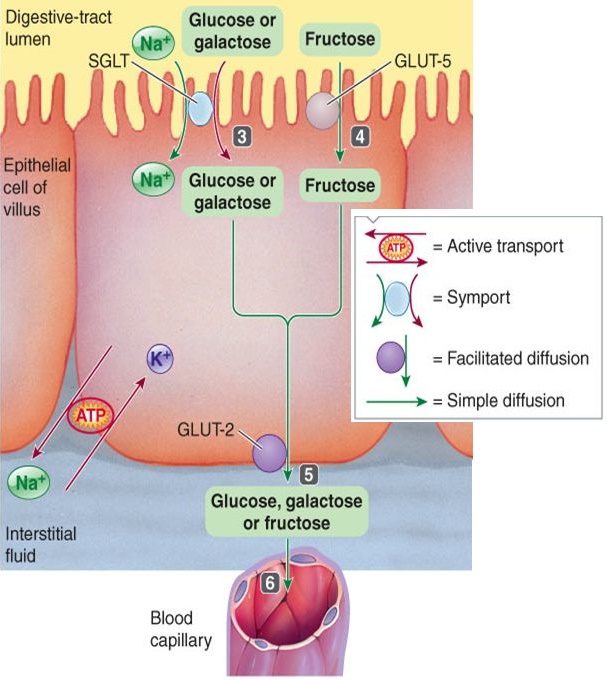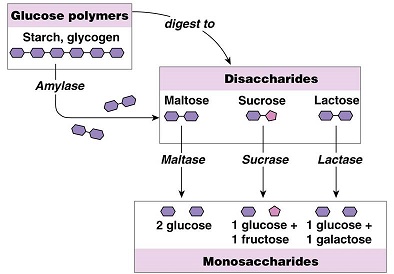Sweeteners

1. Dietary polysaccharides starch and glycogen are converted (hydrolyzed) into the disaccharide maltose via both salivary and pancreatic amylase.
2. Dietary disaccharides sucrose (table sugar), lactose (milk sugar) and maltose are broken down into monosaccharides (glucose, galactose and fructose). This occurs as they come into contact with the hydrolase enzymes sucrase, lactase and maltase residing in the brush borders of the epithelial cells (enterocytes) covering the intestinal villi. Lactose (milk sugar) is the only dietary source of galactase (which is not found elsewhere in nature).

3. The monosaccharides glucose and galactose are absorbed into the epithelial cells (enterocytes). Facilitated by the sodium and energy dependent active transport SGLT symporter in the luminal membrane. SGLT is also known as the sodium-dependent hexose transporter.
4. The monosaccharide fructose takes a different pathway, entering the epithelial cells by passive facilitated diffusion via the GLUT-5 symporter. Fructose is absorbed much slower than glucose and amounts are limited. Overconsuming fructose results in fructose malabsorption with associated bloating, diarrhea and GI discomfort. However, unknown mechanisms allow co-ingestion of glucose with fructose to improve fructose absorption.
5. All 3 monosaccharides exit the epithelial cell by passive facilitated diffusion via the GLUT-2 symporter.
6. Finally, the "3" (glucose, galactose and fructose) enter the capillaries to the portal vein for transport to the liver.
Galactose. Taken up by liver cells (hepatocytes) and primarily converted into glucose and stored as glycogen.
Fructose. Eaten in moderate quantities, most fructose is taken up by the liver and converted to glucose, glycogen and lactate. A fraction is converted into fatty acids and uric acid. A small amount ends up in the bloodstream
Glucose. Only 30-40% taken up by liver. In a fed state liver cells take up glucose. In a fasting state, most glucose (body's main fuel source) is transported in the blood to peripheral tissues, where ideally, INSULIN enables it to be taken up by peripheral cells to produce energy. Glucose blood basal levels are maintained at about 4-5 mmol/L, since the brain requires a constant supply. Surplus glucose is first stored as glycogen in (a) the liver (holds about 3 ½oz) --- used to maintain basal blood glucose level, and (b) in the muscles (about a pound) ---- to be used for movement. Any extra glucose is going into long-term storage as fat! - hence the need to control the amount of incoming sugars and carbs if you don't want to "pay" for storage 😄